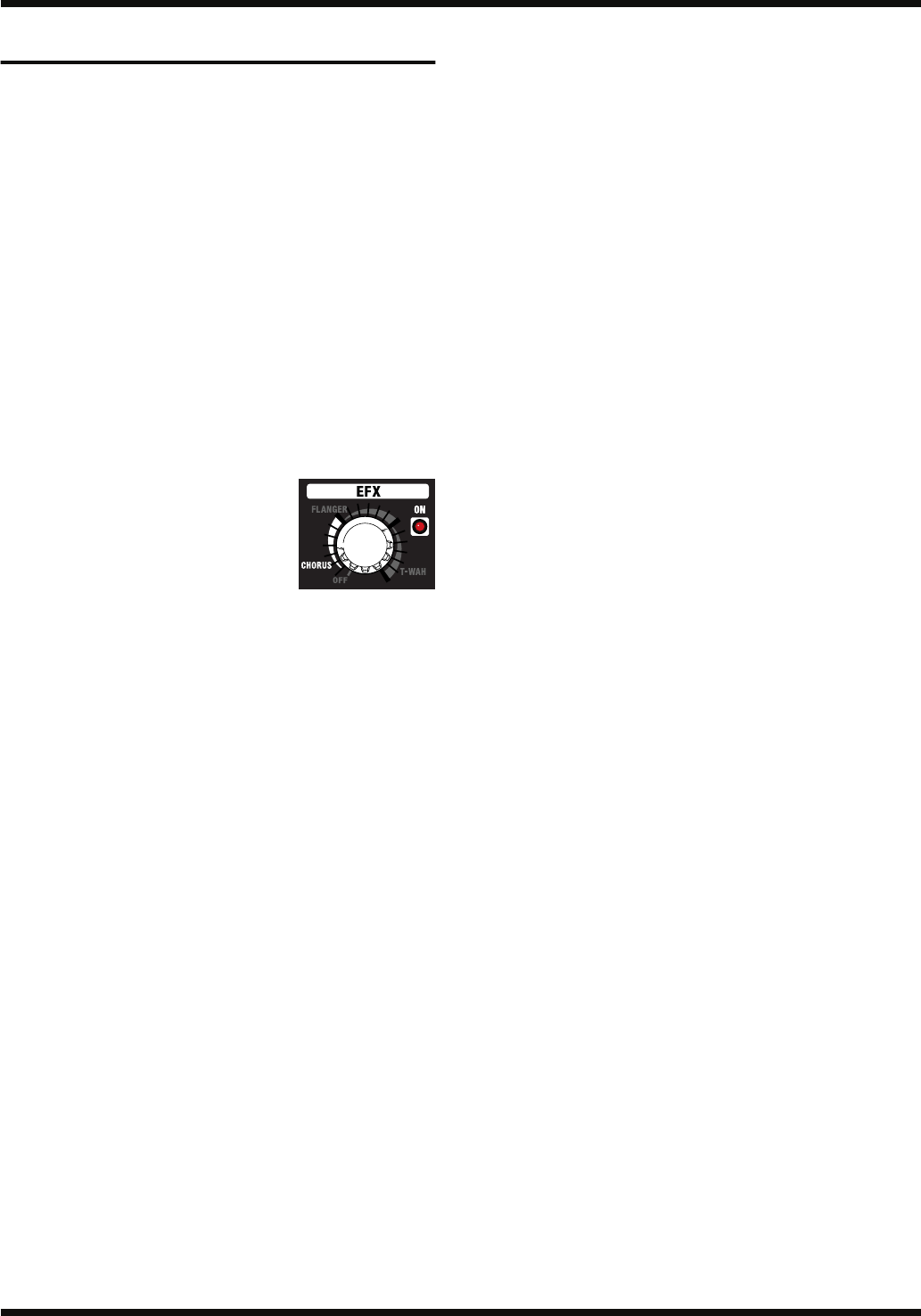
6
Panel Descriptions
EQUALIZER
7. BASS Knob
Adjusts the tone quality of the lower range.
8. MIDDLE Knob
Adjusts the tone quality of the midrange.
9. TREBLE Knob
Adjusts the tone quality of the upper range.
10
. EFX (Effects) Knob
Turn this knob to chorus, flanger, or T-wah to select the
corresponding effect. Turn the knob to adjust the amount of
effect applied.
The ON indicator lights up when EFX is turned on, and goes
out when EFX is turned off. You can also turn EFX on and off
using an optional foot switch (the BOSS FS-5U).
* Graduations for CHORUS, FLANGER and T-WAH on a panel are
for reference. Be sure to check the sound as you adjust the effects.
fig.02
CHORUS
In this effect, a slightly detuned sound is
added to the original sound, giving the
sound greater breadth and fullness.
Turning the knob to the right increases
the rate and deepens the chorus effect.
fig.03
FLANGER
This creates a flanging effect that creates a
sort of spinning sensation with the sound.
Turning the knob to the right increases the
rate and deepens the flanging effect.
fig.04
T-WAH
The frequency response of the filter
changes according to the input level,
producing unique changes in the timbre.
Turning the knob to the right increases
the sensitivity to the input level.
Adjust this to obtain the optimal effect, which is matched with
the output level of your bass.
11
. DELAY/REVERB Knob
Turn this knob to DELAY or REVERB to switch to that effect.
Turn the knob to adjust the amount of effect applied.
* Graduations for DELAY, REVERB on a panel are for reference.
Be sure to check the sound as you adjust the effects.
fig.05a
DELAY
Turn the knob to change the delay time.
fig.05b
REVERB
Turn the knob to adjust the reverb level.
12
. FOOT SW (Foot Switch) Jack
You can use foot switches (the optional BOSS FS-5U) connected
using a connection cable (the optional PCS-31) to turn EFX on
and off, and to turn DELAY/REVERB on and off.
fig.06
* When you connect only one foot switch by mono cable, you can only
use it to turn EFX on and off.
13
. AUX IN Jack
You can connect a CD player or other kind of device and have it
play along with your bass.
This accepts a 1/4” stereo phone plug. However, the speaker
and RECORDING OUT/PHONES output is monaural.
* Determine the volume level by adjusting the volume control of the
connected device.
14
. RECORDING OUT/PHONES Jack
fig.02
When Using This as RECORDING OUT
Use mono 1/4” phone plugs when connecting
to this jack.
The RECORDING OUT volume level can be
set easily by turning the VOLUME knob to a
position within the range shown in the figure.
When Using This as PHONES
Connect headphones to this jack.
* No sound is played through the unit's speaker while the
RECORDING OUT/PHONES jack is in use.
15
. POWER Switch
Turns the power on and off.
941
• Once the connections have been completed, turn on power to
your various devices in the order specified. By turning on
devices in the wrong order, you risk causing malfunction and/or
damage to speakers and other devices.
942
• This unit is equipped with a protection circuit. A brief interval (a
few seconds) after power up is required before the unit will
operate normally.
943
• Always make sure to have the volume level turned down before
switching on power. Even with the volume all the way down,
you may still hear some sound when the power is switched on,
but this is normal, and does not indicate a malfunction.
945
• If you need to turn off the power completely, first turn off the
POWER switch, then unplug the power cord from the power
outlet. Refer to
Power Supply
(p. 4).
16
. Power Indicator
This indicator lights when the unit is turned on.










